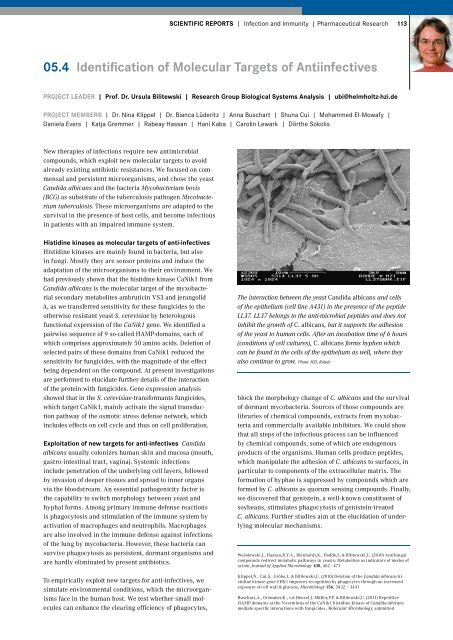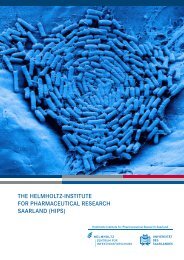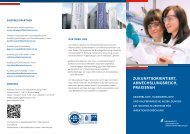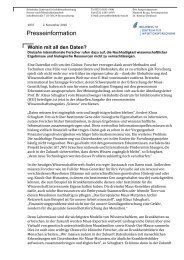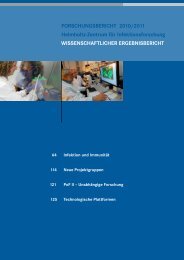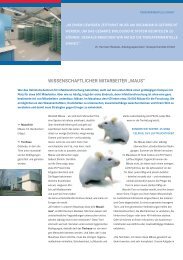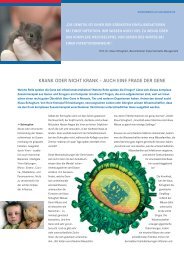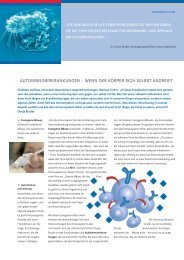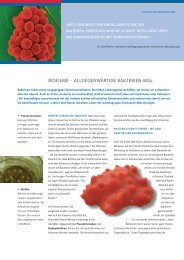Research Report 2010 2011 - Helmholtz-Zentrum für ...
Research Report 2010 2011 - Helmholtz-Zentrum für ...
Research Report 2010 2011 - Helmholtz-Zentrum für ...
You also want an ePaper? Increase the reach of your titles
YUMPU automatically turns print PDFs into web optimized ePapers that Google loves.
SCIENTIFIC REPORTS | Infection and Immunity | Pharmaceutical <strong>Research</strong> 113<br />
05.4 Identification of Molecular Targets of Antiinfectives<br />
PROJECT LEADER | Prof. Dr. Ursula Bilitewski | <strong>Research</strong> Group Biological Systems Analysis | ubi@helmholtz-hzi.de<br />
PROJECT MEMBERS | Dr. Nina Klippel | Dr. Bianca Lüderitz | Anna Buschart | Shuna Cui | Mohammed El-Mowafy |<br />
Daniela Evers | Katja Gremmer | Rabeay Hassan | Hani Kaba | Carolin Lewark | Dörthe Sokolis<br />
New therapies of infections require new antimicrobial<br />
compounds, which exploit new molecular targets to avoid<br />
already existing antibiotic resistances. We focused on commensal<br />
and persistent microorganisms, and chose the yeast<br />
Candida albicans and the bacteria Mycobacterium bovis<br />
(BCG) as substitute of the tuberculosis pathogen Mycobacterium<br />
tuberculosis. These microorganisms are adapted to the<br />
survival in the presence of host cells, and become infectious<br />
in patients with an impaired immune system.<br />
Histidine kinases as molecular targets of anti-infectives<br />
Histidine kinases are mainly found in bacteria, but also<br />
in fungi. Mostly they are sensor proteins and induce the<br />
adaptation of the microorganisms to their environment. We<br />
had previously shown that the histidine kinase CaNik1 from<br />
Candida albicans is the molecular target of the myxobacterial<br />
secondary metabolites ambruticin VS3 and jerangolid<br />
A, as we transferred sensitivity for these fungicides to the<br />
otherwise resistant yeast S. cerevisiae by heterologous<br />
functional expression of the CaNik1 gene. We identified a<br />
pairwise sequence of 9 so-called HAMP-domains, each of<br />
which comprises approximately 50 amino acids. Deletion of<br />
selected pairs of these domains from CaNik1 reduced the<br />
sensitivity for fungicides, with the magnitude of the effect<br />
being dependent on the compound. At present investigations<br />
are performed to elucidate further details of the interaction<br />
of the protein with fungicides. Gene expression analysis<br />
showed that in the S. cerevisiae-transformants fungicides,<br />
which target CaNik1, mainly activate the signal transduction<br />
pathway of the osmotic stress defense network, which<br />
includes effects on cell cycle and thus on cell proliferation.<br />
Exploitation of new targets for anti-infectives Candida<br />
albicans usually colonizes human skin and mucosa (mouth,<br />
gastro-intestinal tract, vagina). Systemic infections<br />
include penetration of the underlying cell layers, followed<br />
by invasion of deeper tissues and spread to inner organs<br />
via the bloodstream. An essential pathogenicity factor is<br />
the capability to switch morphology between yeast and<br />
hyphal forms. Among primary immune defense reactions<br />
is phagocytosis and stimulation of the immune system by<br />
activation of macrophages and neutrophils. Macrophages<br />
are also involved in the immune defense against infections<br />
of the lung by mycobacteria. However, these bacteria can<br />
survive phagocytosis as persistent, dormant organisms and<br />
are hardly eliminated by present antibiotics.<br />
To empirically exploit new targets for anti-infectives, we<br />
simulate environmental conditions, which the microorganisms<br />
face in the human host. We test whether small molecules<br />
can enhance the clearing efficiency of phagocytes,<br />
The interaction between the yeast Candida albicans and cells<br />
of the epithelium (cell line A431) in the presence of the peptide<br />
LL37. LL37 belongs to the anti-microbial peptides and does not<br />
inhibit the growth of C. albicans, but it supports the adhesion<br />
of the yeast to human cells. After an incubation time of 6 hours<br />
(conditions of cell cultures), C. albicans forms hyphen which<br />
can be found in the cells of the epithelium as well, where they<br />
also continue to grow. Photo: HZI, Rohde<br />
block the morphology change of C. albicans and the survival<br />
of dormant mycobacteria. Sources of those compounds are<br />
libraries of chemical compounds, extracts from myxobacteria<br />
and commercially available inhibitors. We could show<br />
that all steps of the infectious process can be influenced<br />
by chemical compounds, some of which are endogenous<br />
products of the organisms. Human cells produce peptides,<br />
which manipulate the adhesion of C. albicans to surfaces, in<br />
particular to components of the extracellular matrix. The<br />
formation of hyphae is suppressed by compounds which are<br />
formed by C. albicans as quorum sensing compounds. Finally,<br />
we discovered that genistein, a well-known constituent of<br />
soybeans, stimulates phagocytosis of genistein-treated<br />
C. albicans. Further studies aim at the elucidation of underlying<br />
molecular mechanisms.<br />
Wesolowski,J., Hassan,R.Y.A., Reinhardt,K., Hodde,S. & Bilitewski,U. (<strong>2010</strong>) Antifungal<br />
compounds redirect metabolic pathways in yeasts: Metabolites as indicators of modes of<br />
action, Journal of Applied Microbiology 108, 462 - 471<br />
Klippel,N., Cui,S., Gröbe,L. & Bilitewski,U. (<strong>2010</strong>) Deletion of the Candida albicans histidine<br />
kinase gene CHK1 improves recognition by phagocytes through an increased<br />
exposure of cell wall ß-glucans, Microbiology 156, 3432 – 3431<br />
Buschart,A., Gremmer,K., v.d.Heuvel,J. Müller,P.P. & Bilitewski,U. (<strong>2011</strong>) Repetitive<br />
HAMP domains at the N-terminus of the CaNik1 histidine kinase of Candida albicans<br />
mediate specific interactions with fungicides, Molecular Microbiology, submitted


